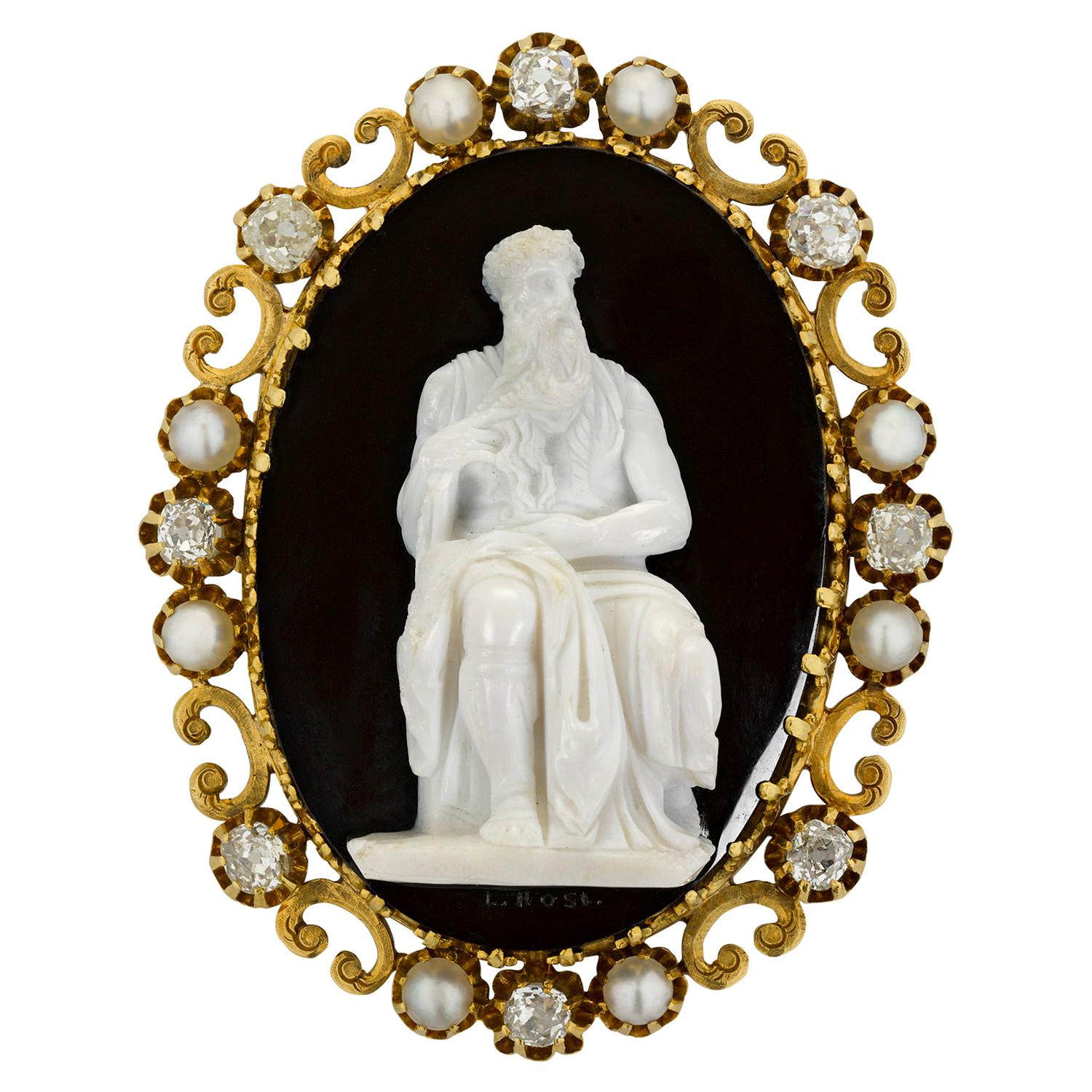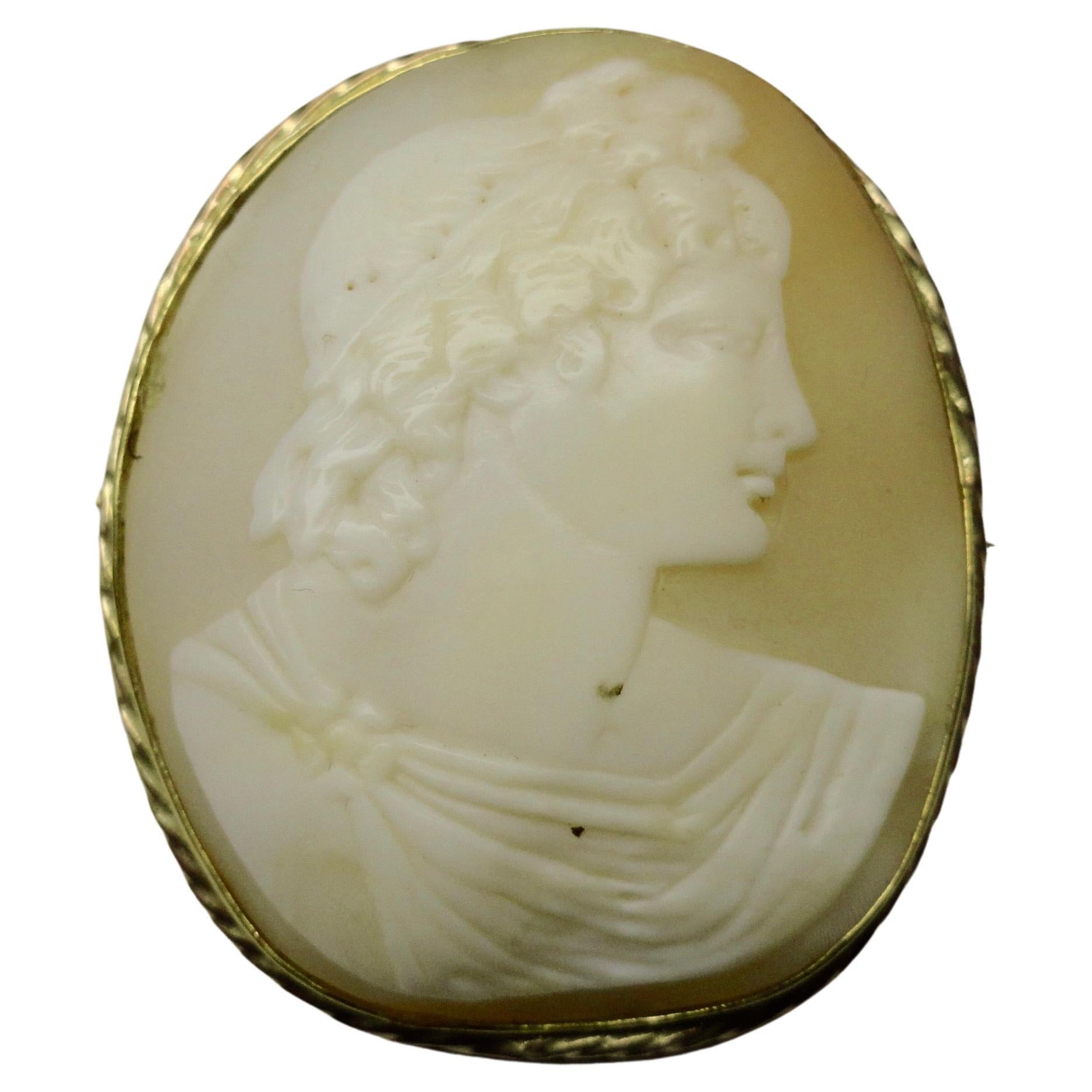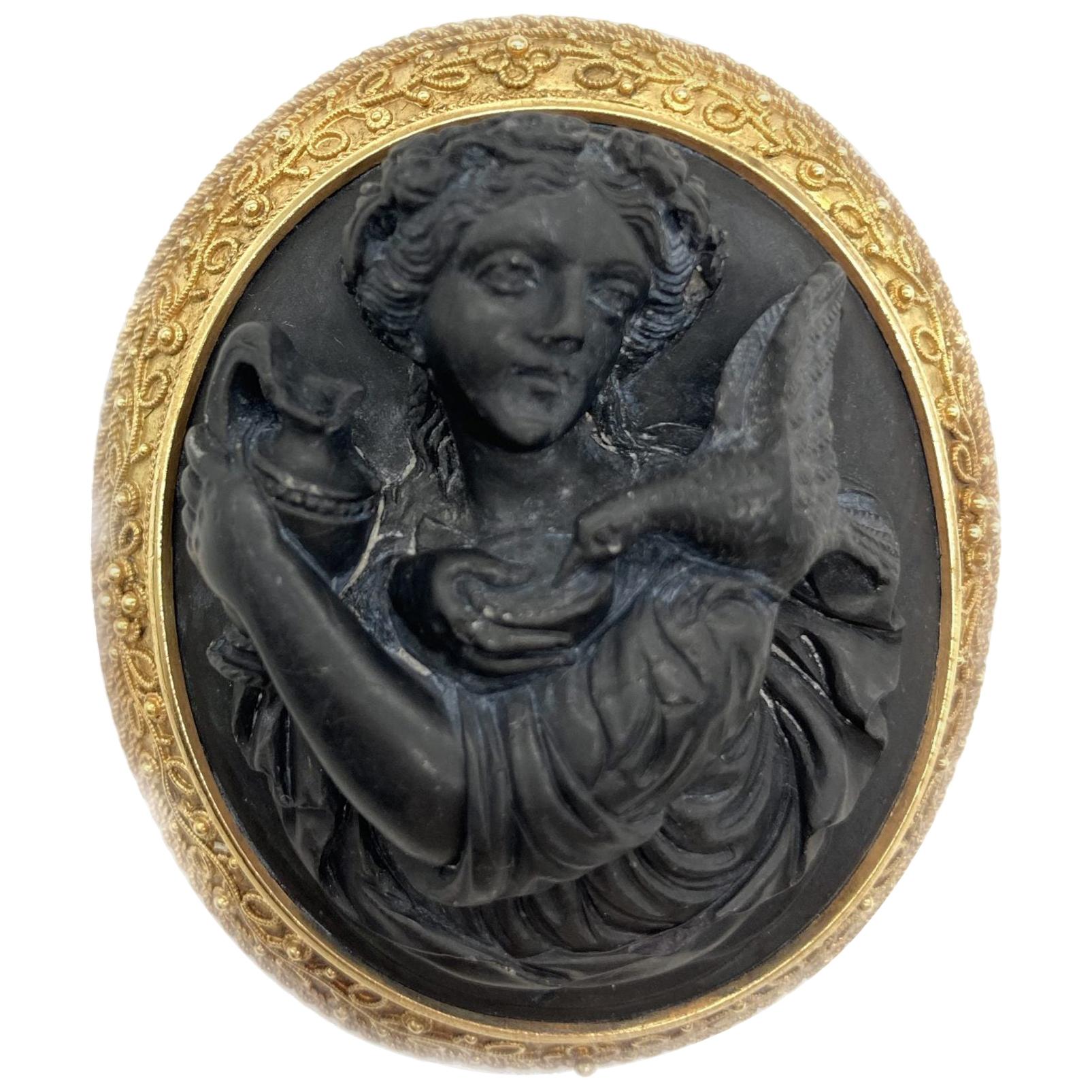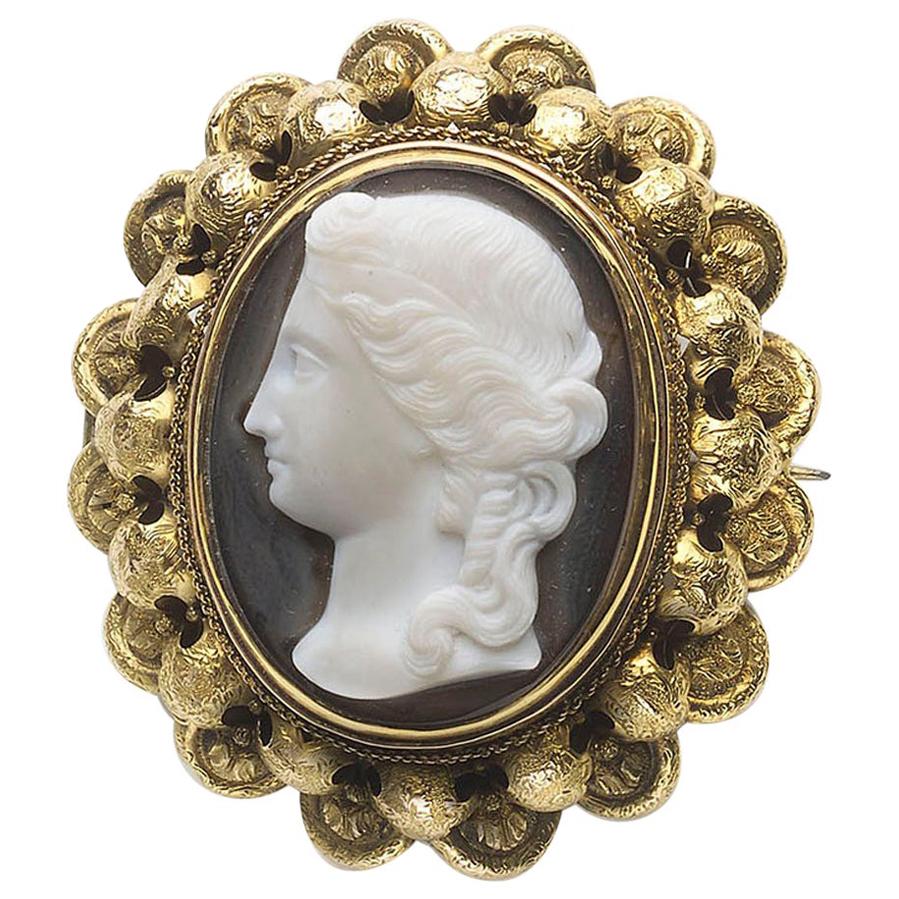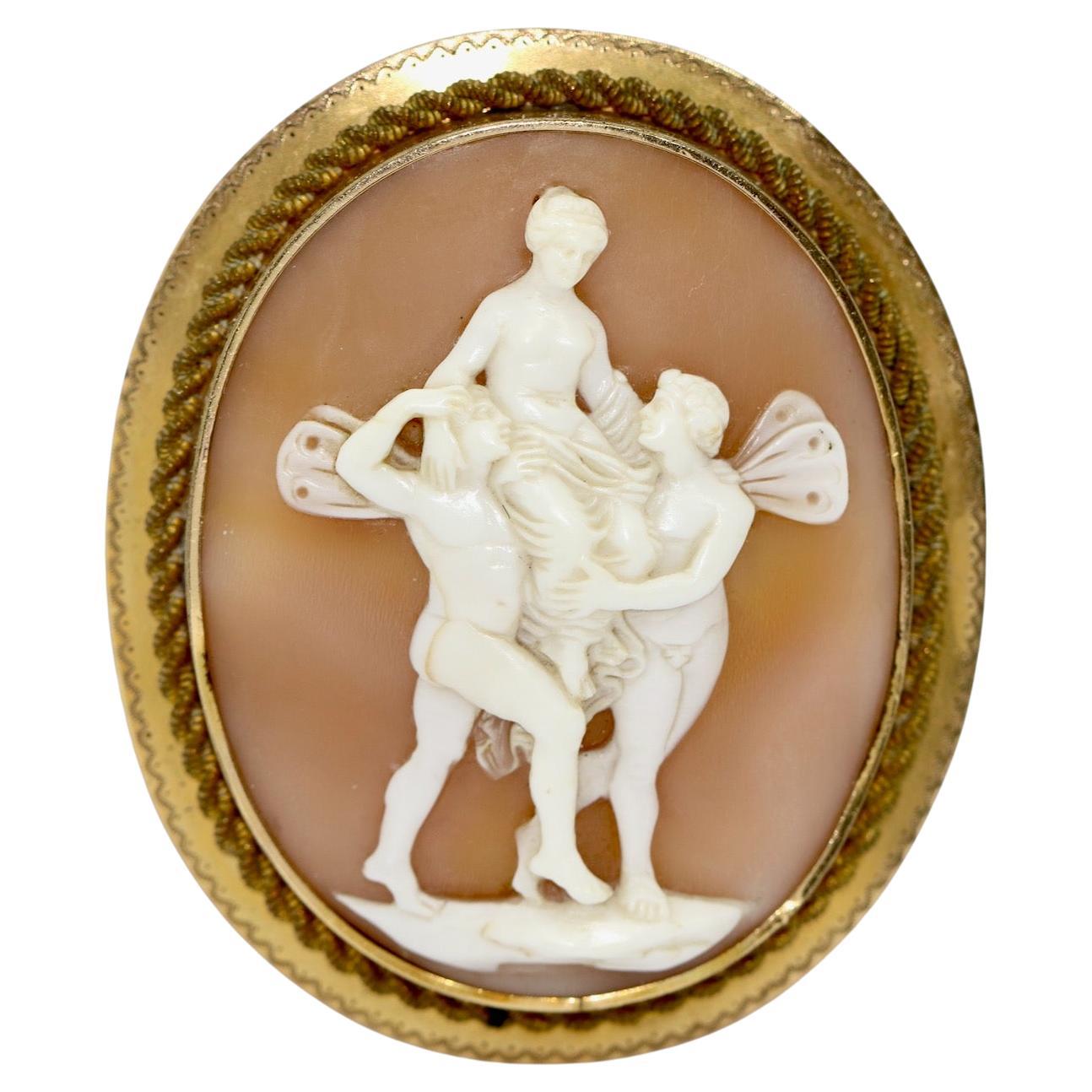Items Similar to Antique Cameo Brooch, circa 1850.
Video Loading
Want more images or videos?
Request additional images or videos from the seller
1 of 8
Antique Cameo Brooch, circa 1850.
About the Item
Hardstone cameo brooch. Set with a carved hardstone cameo to centre of a bust of a lady in profile within a yellow gold ornate horizontal form, with gold wirework, floral beading and terminating with two circular clusters. Fitted with bar and C-clasp to reverse, 18 carat yellow gold, circa 1850.
- Metal:18k Gold
- Style:Victorian
- Period:1850-1859
- Date of Manufacture:1850
- Condition:Wear consistent with age and use.
- Seller Location:London, GB
- Reference Number:
About the Seller
5.0
Recognized Seller
These prestigious sellers are industry leaders and represent the highest echelon for item quality and design.
1stDibs seller since 2011
56 sales on 1stDibs
Typical response time: 3 hours
- ShippingRetrieving quote...Ships From: London, United Kingdom
- Return PolicyA return for this item may be initiated within 3 days of delivery.
More From This SellerView All
- Diamond floral spray brooch, circa 1850.Located in London, GBDiamond floral spray brooch. Set with one drop shape old mine diamond in an open back cutdown setting with a weight of 1.80 carats, and fif...Category
Antique 1850s British Victorian Brooches
MaterialsDiamond, Silver, Yellow Gold
- Victorian hardstone cameo brooch, French, circa 1900Located in London, GBVictorian hardstone cameo brooch. Set with an oval cameo in hardstone depicting the profile of a woman in the classical style, featuring a decorative engraved border and fitted to re...Category
Antique Early 1900s European Victorian Brooches
MaterialsYellow Gold
- John Brogden Shell Cameo Brooch and Earrings, English, circa 1870By John BrogdenLocated in London, GBAntique shell cameo brooch and earrings by John Brogden, English, circa 1870. A yellow gold suite of jewellery, the brooch composed of a horizontally situated oval Bull’s Mouth shell cameo of the Greek goddess Selene riding a serpentine dragon in a rubover collet setting, encircled by a conforming frame of gold beading and twisted gold wire punctuated with four gold palmette form plaques engraved and decorated with dark blue enamel and placed at the cardinal points, the reverse mounted with a hinged pin and scroll clasp, the earrings each composed of a vertical oval Bull’s Mouth shell cameo engraved with a bust length portrait of Selene with crescent-set headdress, encircled by a conforming frame matching that of the brooch with the addition of a pendant decoration composed of a horizontal bar of gold beading and twisted gold wires suspending gold link chains graduated from centre and ending in conical gold elements, the reverses mounted with French wire fittings, all in a fitted red leather case, the interior marked ‘FIRST CLASS PARIS MEDAL/ 1855.1867.1851/ PARIS FIRST CLASS & LONDON PRIZE MEDALS/ JOHN BROGDON/ Goldsmith/ MANUFACTORY/ 16, Henrietta St. Covent Garden/ London’. The cameo—defined as a gem, usually either a mineral or a shell, upon which a design has been carved in relief—is believed to have originated in Hellenistic Greece, during the third century BC. These miniature sculptures, at that time confined to the medium of hardstone, are thought to have been made with the primary purpose of personal adornment. The same practice of mounting cameos in jewellery was then continued by the Ancient Romans, and they are known to have been worn by many a Roman emperor. After the fall of Rome the fashion for cameos went into a decline, until it was again revived during the Renaissance period, brought about by a keen interest in the ancient world. At this time both antique and contemporary cameos were mounted in jewellery, as well as collected as objet d’art. The art of cameo cutting was revived in Italy, where it would remain a centre for the coming centuries. Again there was a lull in interest in carved gemstones, until the Neoclassical revival of the eighteenth century, largely stimulated by the discoveries of the ancient Roman cities of Pompeii and Herculaneum. As with the Renaissance, antique specimens were generally prized over modern cameos, and the worldliest men in Europe held them among their collections of art and antiques. That said, carving centres in Rome and Torre del Greco (near Naples) in Italy were established in response to the demand of the Grand Tourists, who travelled to Italy and Greece to become educated in the wonders of the ancient world. It was at this time that shell cameos, mostly made in Torre del Greco due to its proximity to the sea, became more popular, owing to the relative ease in carving shell over hardstone. In addition to Rome, hardstone cameos also became a specialty of Idar Oberstein, Germany, which had a long history with both the gem mining and cutting trade. In a shift away from the collector’s cases of the previous century, the nineteenth century saw a strengthening in the fashion for wearable cameos. After the Empress Josephine donned a cameo-set suite of jewellery at the coronation of Napoleon in 1804, cameo jewellery became all the rage. Napoleon played a further hand in promoting the art by establishing a gemstone carving school in Paris, inspired by his appreciation for the arts of the ancient world. By the mid-nineteenth century shell cameos, in part due to their lightness compared with hardstone cameos, were the height of fashion. Large shell cameos as well as hardstone cameos were set into contemporary mounts, often as suites of jewellery. Some of the best cameos of the nineteenth century—carved by a select group of recognized carvers—were set into revivalist mounts, corresponding to the subject matter. In Victorian England cameo jewellery was particularly prized, due in part to the fact that the Queen owned and wore a number of cameo jewels. One example which can often be seen in official portraits is the Badge of the Order of Victoria and Albert, carved by Tommaso Saulini of Rome, who also produced cameos for the maker of the present suite, John Brogden. To meet demand some carvers set themselves up in London, including William Schmidt, a German carver from Idar Oberstein, who produced cameos for top London jewellers, including Brogden, Carlo Giuliano and Child & Child. In fact, Schmidt purports to have been the first to carve cameos out of opal, which Brogden reportedly displayed in the Paris Exhibition of 1878. An extant example, now in the collection of the British Museum, was set by the Giuliano firm. Regarding subject matter, cameos throughout time have been largely figural, from bust length profile portraits to scenes with multiple full-length figures, and sometimes animals. Ancient Greek and Roman cameos often depicted mythological scenes as well as contemporary figures. During the Renaissance, mythological scenes were popular, often taken directly from ancient sculpture, as well as portraits of notable contemporary figures. During the eighteenth and nineteenth centuries, due to the revivalist styles, both Renaissance and Classical subjects were copied and set into matching (and sometimes unmatching) revivalist mounts. From the Renaissance through the Victorian era, being able to recognize the source of the carving in a cameo was a mark of erudition, revealing in the wearer knowledge of Classical art. As mentioned, the present cameo parure...Category
Antique 1870s English Victorian Brooches
MaterialsYellow Gold
- Cartier Antique Diamond Bow Brooch, circa 1910By CartierLocated in London, GBCartier antique diamond bow brooch. Set to centre with a cushion shape old mine diamond in an open back millegrain setting with a weight of ...Category
Vintage 1910s Brooches
MaterialsDiamond, Platinum
- Carlo and Arthur Giuliano Antique Diamond Wing Brooch circa 1900Located in London, GBAntique diamond wing brooch, attributed to Carlo and Arthur Giuliano, circa 1900. A gold and silver brooch in the form of a pair of outstretched wings, the wings with one hundred and sixteen pavé set round old cut diamonds with an approximate total weight of 5.80 carats, and additionally set with two old cut drop shaped diamonds set to top and bottom of the centrepiece with an approximate total weight of 2.05 carats. Originally part of a hair ornament. In a fitted Wartski box, authentication courtesy of Wartski. This brooch appears in 'Pre-Raphaelite to Arts and Crafts Jewellery', by Charlotte Gere and Geoffrey Munn, p. 12. Please note shipping to the United States of America requires the purchaser to fill out a CBP 5106 customs form before the item is shipped. This form is a legal requirement for any item over $2,000 which is being imported into the United States. One of the details the form requests is the purchaser’s social security number or importer’s number. One of the most collectable makers of antique jewellery is the London house of Giuliano, founded by the Neapolitan-born Carlo Giuliano, and succeeded by his sons Carlo and Arthur Alphonse. Though unmarked, this piece is likely to have once been a part of a tiara or hair ornament made by Giuliano due to its similarity to other signed pieces by the firm. There are five known pieces, in addition to the present jewel, by Giuliano which are comprised of a pair of diamond set wings with a larger stone or stones placed at centre. All five—a convertible hair ornament/brooch, a tiara, and three brooches—appeared in Wartski’s 1989 exhibition Artists’ Jewellery: Pre-Raphaelite to Arts and Crafts, and additionally two of these five are featured in the book of the same title by Charlotte Gere and Geoffrey Munn. The present piece is most similar to the diamond hair ornament...Category
Antique Early 1900s Brooches
MaterialsYellow Gold, Silver
- Georgian Diamond Brooch, circa 1770Located in London, GBGeorgian diamond brooch/pendant. Centrally set with one cushion shape old mine diamond in a closed back cutdown setting with a weight of 1.10 ca...Category
Antique 1770s Unknown Georgian Brooches
MaterialsDiamond, Rose Gold, Silver
You May Also Like
- Antique Moses Cameo BroochLocated in New Orleans, LAThe legendary Michelangelo's Moses is meticulously recreated in this 19th-century cameo brooch. Crafted of beautiful onyx, the intricate cameo resides in ...Category
Antique 19th Century Unknown Victorian Brooches
MaterialsDiamond, Pearl, 18k Gold, Yellow Gold
- Antique Shell Cameo BroochLocated in Milano, MIAntique shell cameo of very fine manufacture and particular subject depicting a classical male bust, with delicate gold setting. From the beginning of ...Category
Antique 19th Century Brooches
Materials18k Gold
- Antique Pink Cameo BroochLocated in Jacksonville, FLA lovely antique cameo pin. Beautifully carved figure of a lady on semi precious stone. The metal frame features a flowing design which holds a carved pink cameo. 1.24” h x 0.96” w ...Category
20th Century Brooches
Materials14k Gold
- Antique Lava Cameo BroochLocated in New York, NYA nineteenth century yellow gold brooch featuring a carved lava cameo encircled by granulated gold in the archaeological revival style.Category
Antique 19th Century Neoclassical Brooches
MaterialsYellow Gold
- Antique Hardstone Cameo and Gold Brooch, circa 1875Located in London, GBAn antique cameo brooch, with a hardstone sardonyx cameo of a lady, with a Roman hairstyle, on a brown background, in a double row gold frame, ...Category
Antique 1870s Victorian Brooches
MaterialsGold
- Antique, Large Cameo BroochLocated in Berlin, DEBeautiful Antique, Large Cameo Brooch. Romantic scene. Possibly gilded. Very fine and detailed carving. Cameo is signed on the back.Category
Antique 19th Century Baroque Revival Brooches
Recently Viewed
View AllMore Ways To Browse
Antique Tremblant Jewelry
Festoon Brooches
Chanel Pearl Brooch 1995
Akoya Grape
Coral Sterling Brooch
Edmund Halley
Acme Brooch
Brooch Real Orchid
Chanel Pearl Brooch 90s
James Avery Bow
Turquoise Broches
Victorian Enameled Pin
Faux Emerald Brooch
Three Hearts Brooch
Gold Scottish Jewelry Victorian
Robert Goossens Brooch
Plique Butterfly
17th Century Mens Jewelry
